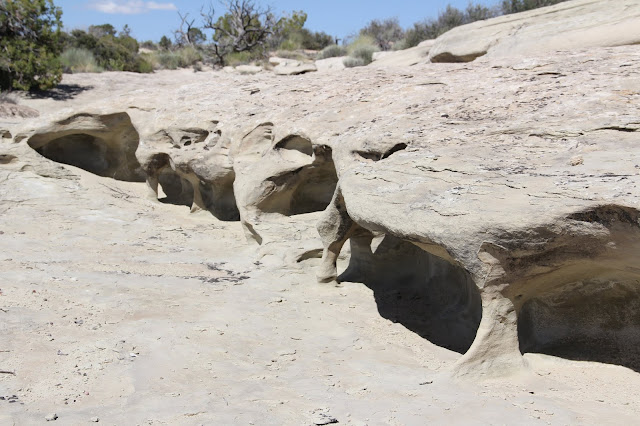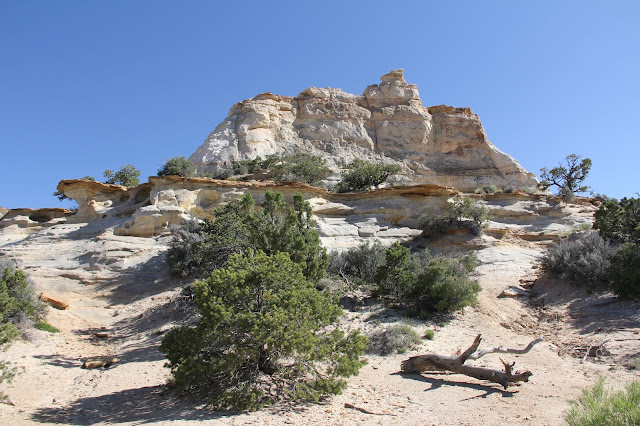 Last Saturday I decided to do a mini road trip to towns, roads and regions of Utah I have yet to visit. My main objective was to drive I-70 from Salina to the Goblin Valley turnoff--the one section of Utah's interstate highways that I have never traversed. To do so I drove a big Triangle. I headed out at 7:15 driving south on I-15--with stops along the way at the never visited towns of Holden, Meadow, and Kanosh--to the western terminus of I-70 at Cove Fort. Then I headed east on I-70 with a side drive down Clear Creek Canyon Road (State Highway 4), a nice visit at the Fremont Indian Sate Park (a first for me), a visit to Monroe, lunch in Richfield, gas and Dr. Pepper in Salina, and then another side trip north to isolated Emery via Utah Highway 10 and back to the interstate along Miller Canyon Road (county road 912), and then across the San Rafael Swell (with three impressive rest stops offering great views and areas to explore) to the junction with Utah Highway 6 near Green River. From there I drove a familiar route northwestward along US 6 back home to Springville.
Last Saturday I decided to do a mini road trip to towns, roads and regions of Utah I have yet to visit. My main objective was to drive I-70 from Salina to the Goblin Valley turnoff--the one section of Utah's interstate highways that I have never traversed. To do so I drove a big Triangle. I headed out at 7:15 driving south on I-15--with stops along the way at the never visited towns of Holden, Meadow, and Kanosh--to the western terminus of I-70 at Cove Fort. Then I headed east on I-70 with a side drive down Clear Creek Canyon Road (State Highway 4), a nice visit at the Fremont Indian Sate Park (a first for me), a visit to Monroe, lunch in Richfield, gas and Dr. Pepper in Salina, and then another side trip north to isolated Emery via Utah Highway 10 and back to the interstate along Miller Canyon Road (county road 912), and then across the San Rafael Swell (with three impressive rest stops offering great views and areas to explore) to the junction with Utah Highway 6 near Green River. From there I drove a familiar route northwestward along US 6 back home to Springville. 
Holden is a well cared for town with lovely yards and old homes. It is just west of the Freeway but is hidden from view by low hills.
At the corner of 300 N and 100 E.
Love the smell and look of these familiar rose bushes in the city park. I grew up thinning out and pruning orange rose bushes like this in our back yard.
Main Street in Meadow.
Fresh mowed alfalfa between Meadow and Kanosh.

Paiute Reservation just north of Kanosh.


There were about a dozen homes along one road (lined by a few trees) on this small reservation, plus a community health center and a nice park.

I was interested to see the Paiute language in use.


The Tithing Office on Main Street.
Kanosh Mercantile. What can't be found here might be found up the road 15 miles in Fillmore. If it's a Walmart you need then your closest options are in Richfield 64 miles to the east, Cedar City 97 miles to the south or Payson 100 miles to the north.
Kanosh from the west.
Black Rock Volcano to the west of town. I drove out to see about climbing to the top. I ended up not climbing but it was interesting to see the large volcanic rock quarry on the south end of the mountain.

Black Rock Volcano (from the south) hides seeing Kanosh from the freeway. For years I have wanted to get off the freeway and go see Kanosh. I finally did.
I-15 with Tabernacle Hill (center) and Tabernacle Crater (to the left of the domed hill) with a cinder cone core protruding up from the center of the crater. To read about our family's visit to that volcanic feature go to this blog post: http://beitemmett.blogspot.com/2017/10/topaz-and-black-rock.html

Clear Creek was running full and muddy.


Newspaper Rock
Cropped close-up of Newspaper Rock. Hiking up to the site is no longer allowed. Perhpas because people like MIKE think it is cool to deface this ancient art.
Drawing of Newspaper Rock.
I hiked the Alma Christensen trail. My Subaru and I-70 below.
Lizard


I-70 with the snow covered Tushar Range in the distance.
Bumblebee
Delightful fragrance and another bumblebee.

Parade of Rock Art trail.

Unusual to see deer in the petroglyphs and not just the usual big horn sheep.
Two people. The one on the right may be a floating deity.
A short hike under I-70 and across Clear Creek to 100 Hands Cave which really is just an over hang with 31 hand prints--pictographs.
From a view point on the north side of the canyon you can see the large and impressive Indian Blanket (center).
At Sheep Shelter the images of sheep are on the inside upper portion of the outside wall. Since grating has been put in place to prevent defacing and graffiti, a mirror has been installed so that visitors can sort of see the sheep.
Monroe in the Sevier River Valley. SS white letters are on the hillside above town for South Sevier High School.
Looking northeastward across the fertile Sevier River Valley towards Richfield.
SS letters between the two buildings.

More yellow roses.


The road never traveled: I-70 (in blue) between Salina (left, off the map) and the road to Goblin Valley (right, red road heading south on the east side of the map).

Old and new church steeples.
Along Miller Canyon Road.
Don't know its name but it could be a Utah Sphinx.
source: https://www.lemkeclimbs.com/san-rafael-swell.html
First I-70 rest stop. Looking south.

Looking northwestward.
Looking southeastward towards Goblin Valley.
Rest Stop 2. Devil's Canyon Viewpoint.
San Rafael Knob.
Devil's Canyon
Ghost Rock Rest Stop. Looking northwestward towards the southern end of the Wasatch Mountains. The towns of Emery, Ferron, Castledale and others sit at the east base of this range in what is known as Castle Valley. The San Rafael Swell then extends eastward from these towns. The San Rafael River runs through this area. One summer the geography faculty canoed down this river and then the boys and I have camped at the Wedge Overlook that looks down from the north rim into the Little Grand Canyon carved by the San Rafael River. For images of our visit to he Wedge see this blog post: http://beitemmett.blogspot.com/2013/11/the-wedge.html
I-70 heading eastward from Ghost Rock. Lots of rain this spring has made for a very green desert.
Chimney Rock
The view northward from up on Ghost Rock.
Ghost Rock

San Rafael Reef was quite an impediment to travel across this region. Eventually Spotted Wolf canyon was blasted wider so I-70 could be built.
Looking east towards Green River.

Got home in time to go watch the Art City Days fireworks show with Marie and Will.































































































Great stuff and pics, as always!
ReplyDelete